Certification Board Of Canada
-
- Industry Pioneer Dr. James McFarlane Sr. International Submarine Engineering Ltd. Marine Technology, Jun 2013 #24
In October, 2011 Dr. James McFarlane Sr. was presented with the Diver Certification Board of Canada’s Lifetime Achievement Award. Prior to receiving that honor, Dr. McFarlane had received numerous awards over the years for his work in developing underwater manned and robotic vehicles and supporting equipment. But it was the comments made by David Parkes, the DCBC’s chief executive officer at the presentation, that gave a more defined picture of Dr. McFarlane than the award itself.
“Jim’s underwater-orientated technical contributions to Canada and the world are almost beyond compare. In just one field of underwater work, Jim has been part of engineering teams that have designed and built more than 400 robotic manipulators and over 200 vehicles,” Parkes said.
For the past 38 years or so for Dr. McFarlane it has been all about creating, designing and building underwater vehicles and support systems. He started his own company, International Submarine Engineering Ltd. (ISC), in 1974 to establish a presence in the underwater industry but even before that, during his 18-year stint in the Canadian Navy, he had been involved in building submarines. Knowingly or not, that work obviously charted the career path for this bright entrepreneur from Canada’s West Coast.
“On Nov 18, 1952, I joined the navy to see the world,” Dr. McFarlane said in a recent interview with MTR. He was sent to Nova Scotia for basic training at CFB Cornwallis and then to CFB Shearwater where he became a navy pilot and certified on the Grumman Avenger and the Hawker Sea Fury.
He chuckled as he referred to himself as “an ordinary seaman/naval airman standard.”
However, during his last years in the navy “I was building submarines in the Chatham Dockyard (on River Medway) in England. By that time I had gone to the University of New Brunswick and MIT in Cambridge (MA). I had already gotten a ticket for driving ships and I was an engineer as well, so I went to England as a constructor of the Oberon class submarines we had in the Canadian Navy for 35 years,” he said.
When he returned to Canada he was posted in Ottawa and his work with submarines continued which really set his future path.
“They (navy) were looking at ways of increasing the diving capability and there were discussions of manned subs at that time and there weren’t really any to speak of. I got involved with the acquisition of one here on the West Coast and I just got involved (in the industry). I left the navy after 18 years and started building manned subs. Then 38 years ago I started ISC to build tethered remotely operated vehicles (ROV) and then started autonomous vehicles (AUV) and all sorts of other kinds of contraptions,” he said.
Sandwiched between his retirement from the navy and the startup of ISE, Dr. McFarlane joined International Hydrodynamics as vice-president of engineering and operations. He had personal responsibility for the development, construction, trials and operations of the company’s submersibles, ancillary equipment and launch and recovery equipment.
Today, ISE and a sister company ISE Research, employ approximately 75 people. The company is based in Port Coquitlam, BC, and develops and builds ROVs, AUVs, manned submersibles, robotic manipulators, semi-submersibles, computer control systems and unmanned surface vessels.
The development of these various forms of underwater equipment and systems is relatively new in the world of industry. Dr. McFarlane, highly regarded around the globe for achievement and innovation in this fledgling business, basically got in on the ground floor. He is often recognized as a pioneer in this field.
However, he modestly doesn’t look at his career and achievements as groundbreaking.
“Well, when it’s ongoing it is hard to evaluate what’s going on. Things are moving right along and it is certainly an adventure,” he said. But the 78-year-old McFarlane does recognize the fact his company’s work has helped revolutionize underwater work and exploration.
“If we hadn’t done it, it would never have been done,” he says.
The company’s record speaks for itself. Over the nearly four decades the company has achieved many firsts. The first commercial ROV in the North Sea in 1976; the ROV TECH ends divers walking inspections of pipelines in the Gulf of Mexico in 1979; the first sub-sea blowout inspection on the Ixtoc-1 in 1979; the first semi-submersible autonomous underwater vehicle Dolphin in 1981 developed for military applications; the first AUV survey ever done in 1982 followed by the longest AUV mission under the ice with AUV, Thesus in 1998.
The “adventure,” as he states, has put ISE at the forefront.
“We started the ROV business pretty well in the world really. We did the first job on the Piper Alpha pipeline (in the U.K.) 30 some years ago and from there I decided that there was going to be a market for autonomous vehicles. I conceived a couple of different kinds and we got money from the Canadian government for opportunities they foresaw as things they wanted to do,” he said.
The development the autonomous vehicles has proven invaluable especially in the Canadian Arctic.
ISE built two built two AUV for Defense Research and Development Canada which were used in collaboration with other federal departments such as National Defense and Fisheries and Oceans in the Arctic to gather data which will used in the establishment of Canada’s undersea boundaries in the North.
“It (collecting the date) it was something that could only have been done in Canada because nobody else had the tools to do it,” Dr. McFarlane said.
The two, cylindrical shaped AUVs built for the Arctic project were each about seven meters long and weighed around 2,000 kg. They had a propeller on the back and six small wings, four were located on the tail and two at the mid-point. These fins enabled the AUVs to fly through the water. They were powered by lithium ion batteries that could be recharged underwater and charge could last for missions as long as 350 – 400 kilometers.
Dave Hopkin, section head, Maritime Assest Protection, Research and Development Canada Atlantic, said in an interview, the two AUVs were invaluable in collecting data that could not have been done with an icebreaker or any other equipment in the Arctic environment. The work done by the AUVs under the ice was to investigate under ocean territory exceeding the 370 kilometers a country automatically gets as an exclusive economic zone.
Hopkin, who has worked on past projects with ISE, said ISE is unique in that they will work with a client to customize the equipment, which occurred in this case when the two AUVs were constructed. This equipment was also unique in that it was very portable. It was built in modules which allowed for it to be dismantaled for transportation purposes and then reassembled.
Dr. McFarlane sees the development of autonomous vehicles as the greatest advancement in the industry thus far.
“We have them down to 5,000 meters,” he said, depths where divers can’t go. Plus, he adds, “these tethered vehicles give you real time pictures and you are working as if you are there but you are unable to cover the kind of territory you can cover with autonomous vehicles.”
And, going forward, he says there is a strong future for the AUVs as the industry finds a greater diversity for their application.
“I think what’s going to happen is a greater diversity of platforms and greater diversity in the applications there of but I do seriously think the exploration of ocean floor for metals and methane is going to prove to be very major work,” he said.
“Methane can be used in automobiles and there are indications that it is all the way round the world so that has its charm. But I really don’t think we know all the possible applications yet,” he said. In an amusing anecdote concerning methane, Dr. McFarlane referred to country singer Wilf Carter, a native of Aulac, New Brunswick, who wrote a song during the Second World War that was called “When the Ice Worms Nest Again.”
“It was played a lot actually but about 10 years ago in the Gulf of Mexico they discovered worms on methane ice,” said Dr. McFarlane and with a hearty chuckle “we said we knew that in Canada years ago, Wilf Carter used to sing about it.”
Dr. McFarlane said his company’s business is expanding and becoming more international. China and Japan are now markets but noted some caution in dealings with China.
“We can sell stuff to them as long as it isn’t massed produced,” he said. But meanwhile ISE has completed construction of four autonomous vehicles for Japan “and we have got more underway and we have got one underway for China.” Dr. McFarlane noted a growing demand for underwater vehicles and equipment with a specific emphasis on equipment for deep water.
At 78 Dr. McFarlane, who is president of ISE, remains active in the daily workings of the company. There is an enthusiasm in his voice when he speaks of its accomplishments and what the future may hold, so it is highly unlikely this industry pioneer - whether he likes that label or not - is about to leave anytime soon.
(As published in the June 2013 edition of Marine Technologies - www.seadiscovery.com)
-
 )
March 2024 - Marine Technology Reporter page: 43
)
March 2024 - Marine Technology Reporter page: 43Image courtesy Kongsberg Discovery Image courtesy Teledyne Marine New Products Teledyne Marine had its traditional mega-booth at Oi, busy start to ? nish. Image courtesy Greg Trauthwein offers quality sub-bottom pro? ling capability without the need tion of offshore windfarms. GeoPulse 2 introduces new
-
 )
March 2024 - Marine Technology Reporter page: 29
)
March 2024 - Marine Technology Reporter page: 29n January, Norway said “yes” to sea- bed mining, adding its weight to the momentum that is likely to override the calls for a moratorium by over 20 countries and companies such as I Google, BMW, Volvo and Samsung. Those against mining aim to protect the unique and largely unknown ecology of the sea?
-
 )
March 2024 - Marine Technology Reporter page: 25
)
March 2024 - Marine Technology Reporter page: 25Auerbach explained that ideally, “one ? ed layers of geothermal activity,” noted changes over an area of 8,000 km2. They would have both instruments: seismom- Skett, “and the change in salinity and dis- found up to seven km3 of displaced ma- eters to detect and locate subsurface ac- solved particles for
-
 )
March 2024 - Marine Technology Reporter page: 23
)
March 2024 - Marine Technology Reporter page: 23elatively inactive since 2014, the Hunga Tonga–Hunga Ha‘apai (HT-HH) submarine volcano began erupting on December 20, 2021, reaching peak intensity on January 15, 2022. This triggered tsunamis throughout the Pa- R ci? c, destroyed lives and infrastructure, and generated the largest explosion recorded
-
 )
March 2024 - Marine Technology Reporter page: 17
)
March 2024 - Marine Technology Reporter page: 17• Integrity assessment, and otherwise covered, e.g., by rock dump. As for depletion of • Mitigation, intervention and repair. sacri? cial anodes, this can be dif? cult or even impossible to Selecting the best method for collecting the data these work- estimate due to poor visibility, the presence of
-
 )
March 2024 - Marine Technology Reporter page: 15
)
March 2024 - Marine Technology Reporter page: 15sensor options for longer mission periods. About the Author For glider users working in ? sheries and conservation, Shea Quinn is the Product Line Manager the Sentinel can run several high-energy passive and active of the Slocum Glider at Teledyne Webb acoustic sensors, on-board processing, and imaging
-
 )
March 2024 - Marine Technology Reporter page: 14
)
March 2024 - Marine Technology Reporter page: 14TECH FEATURE TELEDYNE SLOCUM GLIDERS to hold over 3.5 times as many lithium primary batteries as the the water column and its thrusters give it the ability to stay standard Slocum Glider, and to physically accommodate up to on track in strong currents or other dif? cult ocean condi- 8 different sensor
-
 )
March 2024 - Marine Technology Reporter page: 6
)
March 2024 - Marine Technology Reporter page: 6MTR Editorial Advisors Gallaudet Hardy The Honorable Tim Gallaudet, Kevin Hardy is President PhD, Rear Admiral, U.S. of Global Ocean Design, Navy (ret) is the CEO of creating components and Ocean STL Consulting and subsystems for unmanned host of The American Blue vehicles, following a career
-
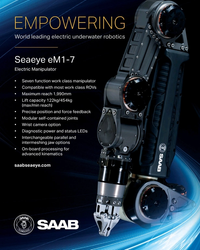 )
March 2024 - Marine Technology Reporter page: 3
)
March 2024 - Marine Technology Reporter page: 3EMPOWERING World leading electric underwater robotics Seaeye eM1-7 Electric Manipulator • Seven function work class manipulator • Compatible with most work class ROVs • Maximum reach 1,990mm • Lift capacity 122kg/454kg (max/min reach) • Precise position and force feedback • Modular self-contained
-
 )
March 2024 - Marine Technology Reporter page: 2
)
March 2024 - Marine Technology Reporter page: 2March/April 2024 On the Cover Volume 67 • Number 3 Image courtesy NIWA-Nippon Foundation TESMaP / Rebekah Parsons-King 8 Subsea Defense Black Sea Mines When the shooting stops in the Ukraine, the tough work of clearing mines will commence. By David Strachan 12 Gliders Slocum Sentinel 22 Teledyne
-
 )
April 2024 - Maritime Reporter and Engineering News page: 43
)
April 2024 - Maritime Reporter and Engineering News page: 43“The industry is an ecosystem which includes owners, managers, mariners, shipyards, equipment makers, designers, research institutes and class societies: all of them are crucial,” – Eero Lehtovaara, Head of Regulatory & Public Affairs, ABB Marine & Ports All images courtesy ABB Marine and Ports provi
-
 )
April 2024 - Maritime Reporter and Engineering News page: 41
)
April 2024 - Maritime Reporter and Engineering News page: 41Nautel provides innovative, industry-leading solutions speci? cally designed for use in harsh maritime environments: • GMDSS/NAVTEX/NAVDAT coastal surveillance and transmission systems • Offshore NDB non-directional radio beacon systems for oil platform, support vessel & wind farm applications
-
 )
April 2024 - Maritime Reporter and Engineering News page: 25
)
April 2024 - Maritime Reporter and Engineering News page: 25RADM PHILIP SOBECK, MILITARY SEALIFT COMMAND Photo by Brian Suriani USN Military Sealift Command From a global supply chain perspective, What makes MSC so vital to the we’ve learned a lot about dealing with Navy’s ? eet and our military disruptions. COVID delivered a big forces around the world? wake-up
-
 )
April 2024 - Maritime Reporter and Engineering News page: 14
)
April 2024 - Maritime Reporter and Engineering News page: 14Book Review Approach to Meeting Underwater Radiated Noise Limits Def ned By Raymond Fischer uantitative underwater radiated noise limits will construction inspections, 5) possible training with respect to be developed shortly by IMO, and/or countries salient design/construction essentials, 6) compliance
-
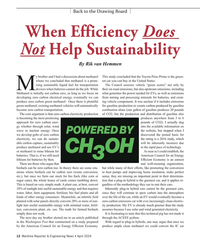 )
April 2024 - Maritime Reporter and Engineering News page: 12
)
April 2024 - Maritime Reporter and Engineering News page: 12Back to the Drawing Board When Efficiency Does Not Help Sustainability By Rik van Hemmen y brother and I had a discussion about methanol This study concluded that the Toyota Prius Prime is the green- where we concluded that methanol is a prom- est car you can buy in the United States. ising sustainable
-
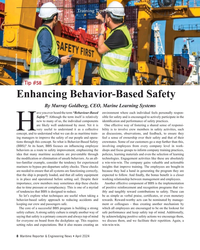 )
April 2024 - Maritime Reporter and Engineering News page: 8
)
April 2024 - Maritime Reporter and Engineering News page: 8Training Tips for Ships © By tuastockphoto/AdobeStock Tip #58 Enhancing Behavior-Based Safety By Murray Goldberg, CEO, Marine Learning Systems ave you ever heard the term “Behaviour-Based environment where each individual feels personally respon- Safety”? Although the term itself is relatively sible for
-
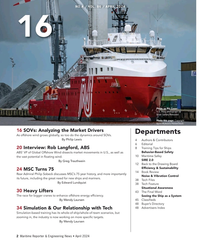 )
April 2024 - Maritime Reporter and Engineering News page: 2
)
April 2024 - Maritime Reporter and Engineering News page: 2NO.4 / VOL. 86 / APRIL 2024 16 Photo on the Cover: U.S. Navy photograph by Brian Suriani/Released Photo this page: Copyright Björn Wylezich/AdobeStock 16 SOVs: Analyzing the Market Drivers Departments As offshore wind grows globally, so too do the dynamics around SOVs. By Philip Lewis 4 Authors & Contribut
-
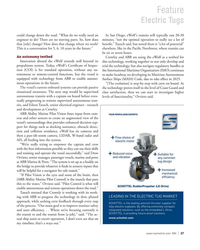 )
April 2024 - Marine News page: 37
)
April 2024 - Marine News page: 37Feature Electric Tugs could change down the road. “What do we really need an In San Diego, eWolf’s transits will typically run 20-30 engineer to do? There are no moving parts. So, how does minutes, “not the optimal operation to really see a lot of that [role] change? How does that change where we work?
-
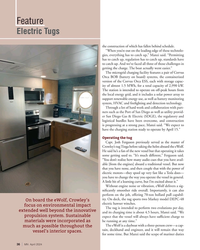 )
April 2024 - Marine News page: 36
)
April 2024 - Marine News page: 36Feature Electric Tugs the construction of which has fallen behind schedule. “When you’re out on the leading edge of these technolo- gies, everything has to catch up,” Manzi said. “Permitting has to catch up, regulation has to catch up, standards have to catch up. And we’ve faced all three of those challenge
-
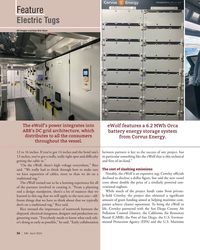 )
April 2024 - Marine News page: 34
)
April 2024 - Marine News page: 34Feature Electric Tugs All images courtesy Eric Haun The eWolf’s power integrates into eWolf features a 6.2 MWh Orca ABB’s DC grid architecture, which battery energy storage system distributes to all the consumers from Corvus Energy. throughout the vessel. 12 to 16 inches. If you’ve got 14 inches and
-
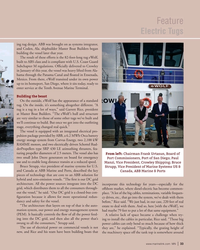 )
April 2024 - Marine News page: 33
)
April 2024 - Marine News page: 33Feature Electric Tugs ing tug design. ABB was brought on as systems integrator, and Coden, Ala. shipbuilder Master Boat Builders began building the vessel later that year. The result of these efforts is the 82-foot-long tug eWolf, built to ABS class and is compliant with U.S. Coast Guard Subchapter M
-
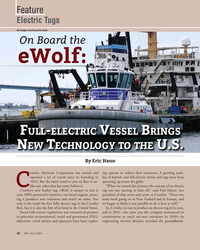 )
April 2024 - Marine News page: 32
)
April 2024 - Marine News page: 32Feature Electric Tugs All images courtesy Eric Haun On Board the eWolf: F - V B ULL ELECTRIC ESSEL RINGS EW ECHNOLOGY TO THE N T U.S. By Eric Haun rowley Maritime Corporation has owned and ing options to reduce their emissions. A growing num- operated a lot of vessels since its founding in ber
-
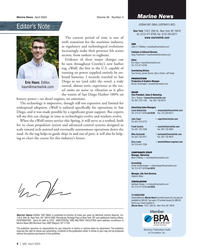 )
April 2024 - Marine News page: 4
)
April 2024 - Marine News page: 4Marine News April 2024 Volume 35 Number 4 Marine News (ISSN#1087-3864) (USPS#013-952) Editor’s Note New York: 118 E. 25th St., New York, NY 10010 tel: (212) 477-6700; fax: (212) 254-6271 www.marinelink.com The current period of time is one of swift transition for the maritime industry, CEO as regulatory
-
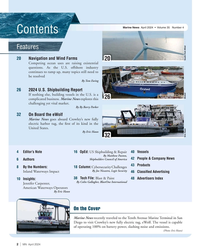 )
April 2024 - Marine News page: 2
)
April 2024 - Marine News page: 2Marine News April 2024 • Volume 35 Number 4 Contents Features 20 Navigation and Wind Farms 20 Competing ocean uses are raising existential questions. As the U.S. offshore industry continues to ramp up, many topics still need to be resolved By Tom Ewing 26 2024 U.S. Shipbuilding Report If
